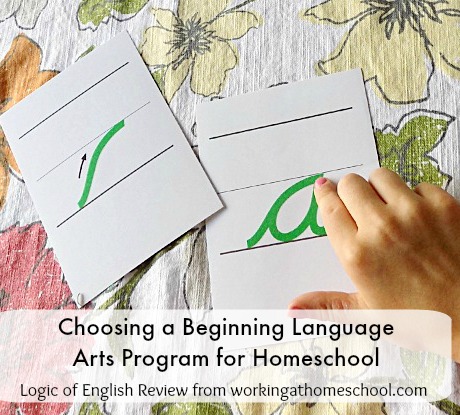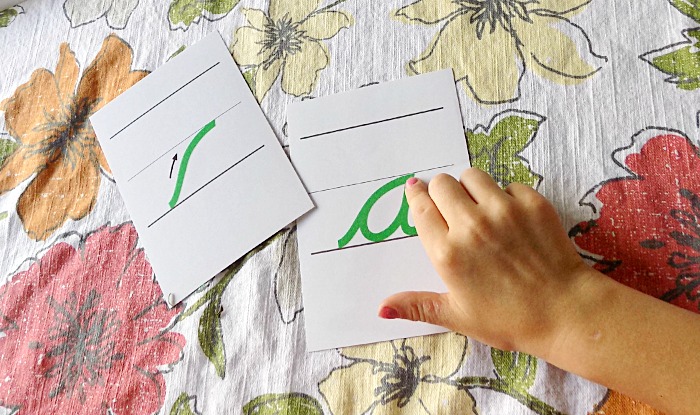Language Arts Homeschool Curriculum – Logic of English Review
This post contains links to affiliate websites, such as Amazon, and we receive an affiliate commission for any purchases made by you using these links. We appreciate your support!
As a parent with five kids (gulp), who homeschools (double gulp) I'm always looking to re-evaluate all aspects of what we do for school. What's working, what's not working, what's boring, what's exciting, what the kids hate, what I hate, and what we all love. I'm always very careful when I choose homeschool curriculum, but I came to the point in our second year of My Father's World where I realized that the Language Arts I had chosen just wasn't cutting the mustard, as a friend of mine would say. I could get into a huge rabbit trail here about that bizarre expression, but I'll spare you.
After some desperate searching and researching for the right language arts homeschool curriculum, I found the program “Logic of English.” It was highly recommended to me by a veteran homeschool mom who had had similar Language Arts issues, and I contacted the company to see if they would let me review their product and test it on my subjects – er, children – to see how we liked it. Logic of English provided their “Foundations” course for me to review, but this is my honest opinion and not influenced by receiving the product.
I've had Foundations for four months, and tested it for that long because I wanted to give a truly honest review, and observe how my children did even while taking six weeks off for a new baby. So we definitely tested the limits with this program to get a really good idea of how it works, how they retain information, and what we liked and disliked.
The Foundations set comes with the following: Teacher's Manual, Student workbooks, Doodling Dragons book, Basic Phonogram flash cards, Phonogram game cards, Phonogram game tiles, Phonogram quick reference chart, Spelling Analysis card, Tactile Handwriting Cards, whiteboard, and a Rhythm of Handwriting quick reference chart.
When I review a product or curriculum, I like to jump right in to the pros and cons so you can get a feel for the product, so here we go:
Pros:
Logic of English Foundations provides a complete curriculum, if you buy the full package. You definitely get your money's worth, from my experience with other language arts programs. This is a program to teach your children to read and write, and at four months in, I believe it really works. Everything called for with the program has already been in our house and I haven't had to buy anything extra. You will need a dry erase marker (I already had some in my house so I was able to start without purchasing anything at all).
Logic of English allows you to choose which to teach first – printing or cursive. We chose cursive, as Logic of English recommends, because when we did Abeka for Kindergarten with my now-sixth-grader, she learned cursive first and never forgot it. The kids in our family who were taught cursive first have had a much easier time writing than those who were taught printing first, so I'm glad for the chance to start my six-year-old out with cursive through Logic of English.
Logic of English teaches phonograms, which is not something we introduced right away with our older student. However, learning phonograms has definitely made it easier for my kids to read and write, so I really wish I'd done it before!
The Teacher's Manual is extremely comprehensive. It starts with Scope and Sequence, so you can see what will be taught in each lesson. One of the things I really love about the TM is that it tells you specifically what to say. Some parents may not like this, but I have never been great with teaching LA to my kids, and it makes it so much easier for me when the book spells out exactly what to say. The lessons are very self-explanatory and there's no guessing, which is something I definitely appreciate. The TM is also laid out very well. I've had a LOT of experience with a LOT of different teacher's manuals, and let me tell you – a good layout can make all the difference! I love the format!
Each lesson has clear objectives.
Logic of English teaches phonograms, which is not something we introduced right away with our older student. However, learning phonograms has definitely made it easier for my kids to read and write, so I really wish I'd done it before!
Apps! – Logic of English has a “Doodling Dragons” app and “Phonics with Phonograms” app available for purchase if you want your kids to get more practice and reinforce what they've learned (this is very, very useful for waiting at the doctor's office, or getting your car serviced, or basically any situation where you feel your sanity is at risk with kids who don't like to sit still).
There are 40 lessons, so you don't have to do one every single day throughout the school year, which is reaaaally nice when you're teaching so many kids.
Logic of English Foundations is multi-age, for ages 4-7. Even my 7-year-old, who has more “Language Arts experience” under her belt, has loved doing this program with her younger brother and has become a MUCH stronger reader AND learned to write cursive much better through Logic of English. You do need to purchase additional supplies if you are teaching more than one child.
There's a breakdown of the structure of each lesson at the Logic of English website. Basically each lesson is broken into three parts, which is nice because my kids know what to expect.
The lessons have taken us anywhere from 10 – 25 minutes, which is great for teaching two students at once.
There is a review after every fifth lesson, which is great for my kids.
The handwriting tactile cards are great for kids who are struggling. I made something similar (although not nearly as nice!) for one of my kids who struggled with dyslexia, so I love that these are included in the program.
Finally, my very favorite part of the curriculum – the GAMES! Yes, there is a really fun book called “Doodling Dragons” that's part of the Foundations set, and my kids love that, too. But the best part of Logic of English, in my opinion, is the silly games. They only take a few minutes, but my kids look forward to them every lesson and always remember what they've learned so much better after we play.
Cons:
I had a bit of a hard time remembering the strokes that are taught before the actual forming of letters is taught. Since I had a hard time, my kids did, too. However, once we mastered the strokes, they did have a much easier time learning to write their letters, because instead of writing a cursive letter from start-to-finish, it was broken down into steps.
When we took a six-week baby break, the kids did not retain all of the cursive writing they learned. They did retain more than I had anticipated, honestly, and this may say more about me or the kids than it does about Logic of English, but we did have to go back and do quite a bit of review of the strokes and cursive letters. However, once we did review it, they seemed to get right back into the swing of things.
This is 100% parent-led, which may fall into the “pros” category for lots of parents! This requires full parental involvement, as with most curriculum choices for kids of this age.
Logic of English is an excellent, comprehensive Language Arts curriculum, and definitely a positive addition to our schoolwork with My Father's World. It is a bit more time intensive than the LA recommended by MFW, but in my opinion it is far more effective AND far more fun. Logic of English provides a nice break in our school day, where the kids can learn something new and jump around for a few minutes playing a game. I am very impressed with the depth of this program and feel that I've finally been able to provide my children with a strong start for reading, writing, and spelling. An unexpected benefit is better speech – Foundations teaches using your voice box, mouth, and tongue for each sound. You have to be ready to invest the time (even 20 minutes every few days can occasionally feel like a lot if you have a big family, I'll be honest), but if you stick with it, I truly believe this is a successful program, and I'm thankful for the opportunity to use it with my kids.
 Copyright secured by Digiprove © 2015
Copyright secured by Digiprove © 2015









Thank you for this review! I haven’t heard of this until reading about it here.
I have just a couple of questions, if you don’t mind.
Did you start out with A/B?
How did it teach you to vocalize the sounds?
Thanks!
p.s. you might have some duplicate points in your “pro” section. (copy and paste) 🙂
Thanks for pointing that out! Yes, we started with A/B, and the kids really enjoy it and have learned a LOT from it. The book segments the sounds phonetically, then gives instructions to put your hand on your throat, or use your lips in this way, etc. The vocalization has been one of the most interesting parts for me as a teacher so far! It’s something that I never really thought much about, but it’s definitely impacting the way my kids pronounce their words.
Valuable information! It is true that happiness comes with children in the family. However, such happiness could be achieved if you are responsible enough with your children. You need to provide all of their needs, starting from their infancy until the time that they are studying. Thank you
I noticed on another post you weren’t using logic of english anymore (or so it seemed.) Can you share why?
Hi.
I am looking at this curriculum specifically for the vocalization component. Is there any possible way you could email me the page on how they recommend pronouncing the letter “r”? I believe it is lesson 25 in Foundations A? I would like to use that as my test case with my son to see if it works for him.
Thanks so much!
Jeanne